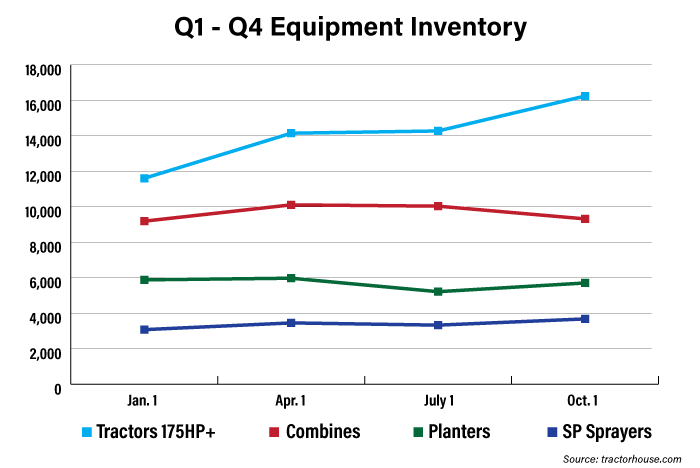As we look toward 2025, the agricultural equipment market stands at a crossroads shaped by potential declines in interest rates and slight increases in commodity prices, particularly for corn and wheat. While these factors may create a sense of optimism, the overarching sentiment in the used equipment market is marked by uncertainty. This uncertainty could lead end-user producers to adopt a "wait and see" approach as they navigate their purchasing decisions in 2025 and 2026.
In the latter part of 2024, we are witnessing increased used tractor supplies as the market transitions from the third to the fourth quarter. The seasonal delivery of new machines and the expiration of seasonal lease contracts contribute to the increase in used inventories. Historically, the fourth quarter has been a time for farmers to take advantage of buying equipment for tax incentives, which can reduce and shuffle the used equipment market. This boost in supply could present opportunities for buyers, but it also raises questions about pricing stability as the balance between supply and demand becomes crucial.
The interest rate environment is one of the most critical variables in the agricultural equipment market. If interest rates decline, financing for equipment purchases and operating lines of credit will likely become more accessible and affordable for farmers. Lower interest rates can ease the financial burden on producers, allowing them to consider investing in used tractors without overextending their budgets. When attractive financing options subsidized by equipment dealers — such as 12-24 month waivers and rates around 2.9% for 60 months — are available, many farmers might feel encouraged to explore purchasing used equipment. This psychological shift may lead to a more proactive approach to acquiring machinery, stimulating demand in the used tractor market.
In tandem with interest rates, commodity prices play a significant role in shaping the agricultural landscape. Anticipating slightly higher prices for key crops like corn and wheat could improve farmers' profitability, encouraging them to invest in their operations. When commodity prices rise, farmers are generally more inclined to spend, viewing it as an opportunity to capitalize on improved margins. However, even with slightly elevated prices, it is essential to recognize the potential volatility in the agricultural sector. Price fluctuations can occur due to various factors, including weather patterns and global supply and demand dynamics. Therefore, producers may remain cautious, weighing their options before committing to significant expenditures.
Despite these positive indicators, the overall sentiment in the used equipment market is uncertain. Many farmers are likely to approach their purchasing decisions cautiously, mindful of the unpredictable nature of agricultural economics. While some may feel motivated to upgrade their fleets with used tractors, others may hesitate, preferring to hold onto their existing machinery until market conditions stabilize. The anticipated reduction in new equipment sales for 2025 could create a demand gap for late-model, low-hour machinery, typically leading to increased demand for used tractors. However, questions about future commodity prices, interest rate stability, and potential economic shifts may continue to deter immediate purchases.
As we move into 2025, declining interest rates and modestly improved commodity prices may present some opportunities in the used tractor market. However, the prevailing uncertainty will likely keep end-user producers on the sidelines, adopting a wait-and-see strategy. They may delay purchasing decisions until they gain clarity on the trajectory of interest rates and commodity prices while monitoring how peers respond to the evolving market landscape.
In summary, while potential declines in interest rates and slight increases in commodity prices for corn and wheat may offer some positive signals for the used tractor market, the overarching uncertainty will likely keep end-user producers cautious. The future of the used equipment market will depend on how these various factors interact and evolve. Producers must remain vigilant, adapting their strategies to the changing landscape while seeking to position themselves for success in an ever-shifting environment.







